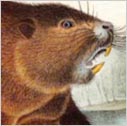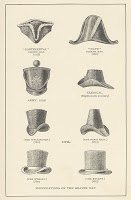
Book Review: Fur, Fortune, and Empire

There's a beaver living on the Grand Marais Harbor. As a recent transplant to Grand Marais, I missed last summer's drama, but locals tell me the beaver ruffled some feathers by doing what beavers do: chomping down trees throughout town.
My intention is not to open old wounds; instead, let's take advantage of the juxtaposition of beaver and folk school. A recent trip up to the classy new interpretive center at Grand Portage National Monument AND instructor Brent Gurtek's trade gun class here at North House ignited my curiosity about the fur trade on Lake Superior (not to mention that I'm from Duluth, a city named after Daniel Greysolon, a French fur-trader/explorer, AND that I listened to voyageur songs on tape when young, so I had plenty of opportunities to get curious...). I checked out Fur, Fortune, and Empire: the epic history of the fur trade in America by Eric Jay Dolin, a detailed account of just how the fur trade shaped American history and settlement. The Grand Marais Public Library even had it on CD. Score. Perfect for a road trip down to the Cities. Here's the scoop, 10 disks later...
Furs had been the rage in Europe, documented from at least the 1200's. Dolin throws out interesting facts: King Henry IV wore a robe made from 12,000 squirrels and 80 ermine, and Henry VIII's robe cost 6,000 times the daily wage of a commoner. No surprise, fur equaled wealth and high fashion. So, as fishermen started chasing cod over to the New World, they took note of the furry gold mine. Even Henry Hudson, while searching for an easy street to Asia, was impressed with the furs Native Americans wore in modern day Manhattan. Enter other players: traders, colonists and explorers. French and English vie for Native American support, war over territory a few times, upsetting the new generations of Americans wanting to push Westward, incite the revolutionary war...the rest is history. All of this because dead beavers make nice hats.
Dolin does a nice job connecting the historical dots back to the fur trade, and I highly recommend his book. Living up to my ears in craft at North House, I couldn't help but notice all the craft cameos—trade guns, birch bark canoes, baidarkas, flourishing Native American art—and how these, in turn, affected the fur trade ( I'll highlight a few of these gems in future posts).
Long story short, we have a living specimen of the once near-extinct castor canadensis living right here in Grand Marais, the rodent equivalent of an artist-in-residence. At the very least he inspired me to read a book.


